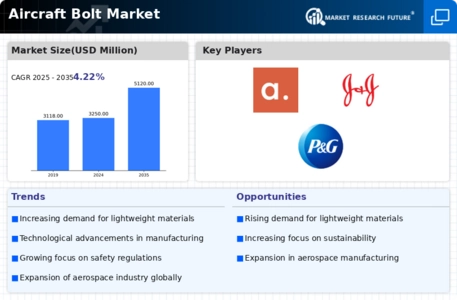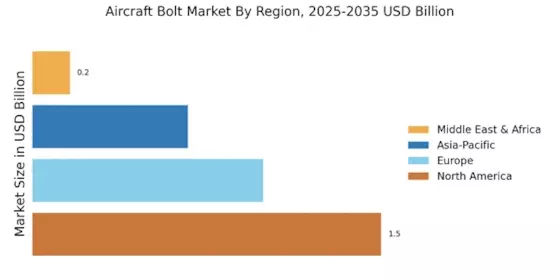Emerging Markets and Globalization
The Aircraft Bolt Market is benefiting from the emergence of new markets and the ongoing globalization of the aerospace sector. Countries with developing aviation industries are increasingly investing in aircraft manufacturing and maintenance capabilities, leading to a heightened demand for aircraft bolts. In 2025, it is expected that regions such as Asia-Pacific and Latin America will witness substantial growth in their aviation sectors, driven by rising disposable incomes and increased air travel. This trend presents a significant opportunity for manufacturers in the Aircraft Bolt Market to expand their reach and establish a presence in these burgeoning markets. As these regions develop their aerospace capabilities, the demand for high-quality aircraft bolts is likely to rise, further enhancing the market landscape.
Regulatory Compliance and Safety Standards
The Aircraft Bolt Market is significantly influenced by stringent regulatory compliance and safety standards imposed by aviation authorities. These regulations mandate the use of high-quality materials and manufacturing processes to ensure the safety and reliability of aircraft components. As a result, manufacturers are compelled to adhere to these standards, which often leads to increased demand for specialized aircraft bolts that meet or exceed regulatory requirements. In 2025, the emphasis on safety is expected to drive a notable increase in the procurement of certified aircraft bolts, thereby enhancing the overall market landscape. This focus on compliance not only ensures passenger safety but also fosters trust in the aviation industry, further propelling the Aircraft Bolt Market.
Increasing Demand for Aircraft Manufacturing
The Aircraft Bolt Market is experiencing a surge in demand due to the increasing production rates of commercial and military aircraft. As airlines expand their fleets to accommodate rising passenger numbers, the need for reliable and high-quality aircraft components, including bolts, becomes paramount. In 2025, the aircraft manufacturing sector is projected to grow at a compound annual growth rate of approximately 4.5%, which directly influences the demand for aircraft bolts. This growth is driven by the need for enhanced safety and performance standards in aviation, necessitating the use of advanced fastening solutions. Consequently, manufacturers in the Aircraft Bolt Market are likely to invest in innovative designs and materials to meet these evolving requirements.
Technological Innovations in Fastening Solutions
The Aircraft Bolt Market is witnessing a wave of technological innovations that are transforming fastening solutions. Advancements in materials science and manufacturing techniques are enabling the production of aircraft bolts that are lighter, stronger, and more resistant to environmental factors. For instance, the introduction of composite materials and advanced coatings is enhancing the performance and longevity of bolts used in aircraft. In 2025, it is anticipated that these innovations will lead to a significant shift in the types of bolts utilized in aircraft assembly, as manufacturers seek to optimize performance and reduce weight. This trend not only benefits the Aircraft Bolt Market but also aligns with the broader industry goals of improving fuel efficiency and reducing emissions.
Growth of the Aerospace Maintenance, Repair, and Overhaul (MRO) Sector
The Aircraft Bolt Market is positively impacted by the growth of the aerospace maintenance, repair, and overhaul (MRO) sector. As aircraft fleets age, the demand for maintenance and repair services increases, leading to a higher requirement for replacement parts, including aircraft bolts. In 2025, the MRO market is projected to expand at a rate of approximately 5%, driven by the need for regular inspections and upgrades to ensure compliance with safety regulations. This growth presents a lucrative opportunity for manufacturers in the Aircraft Bolt Market, as they can cater to the rising demand for high-quality replacement bolts that meet stringent safety standards. The MRO sector's expansion is likely to create a sustained demand for aircraft bolts, thereby bolstering the overall market.


















Leave a Comment